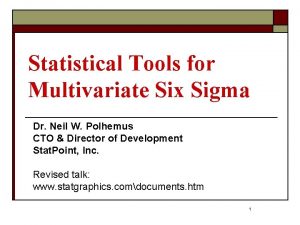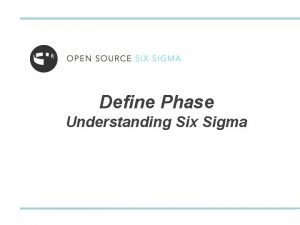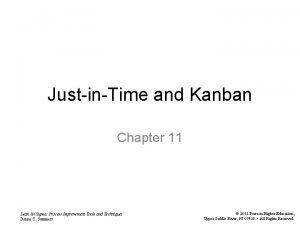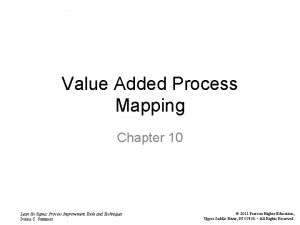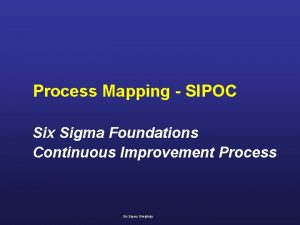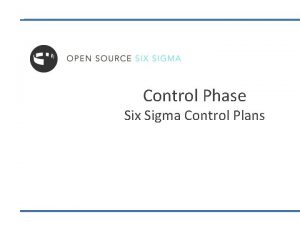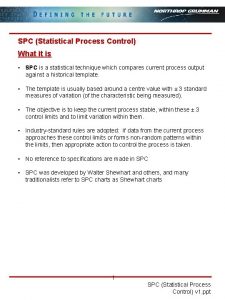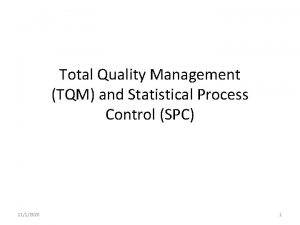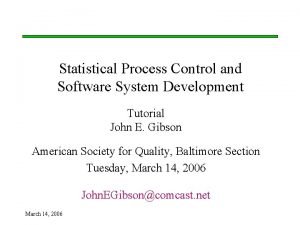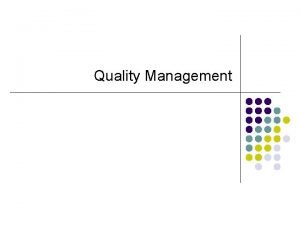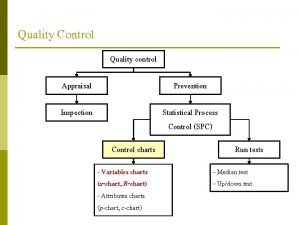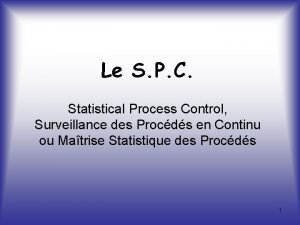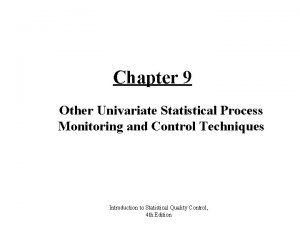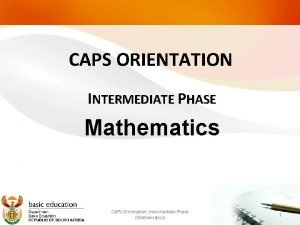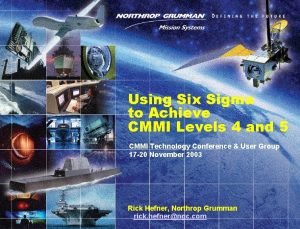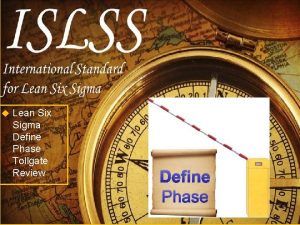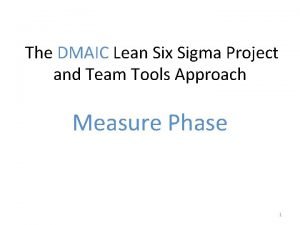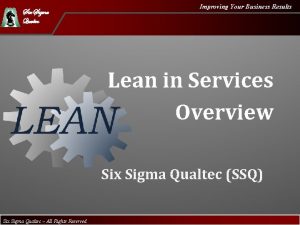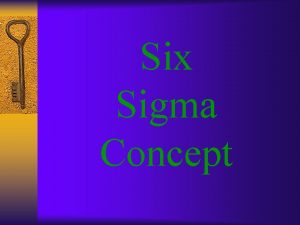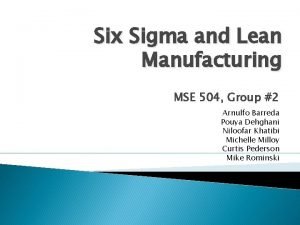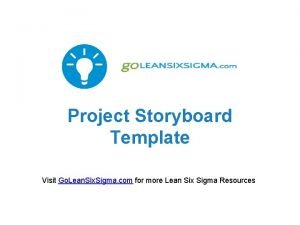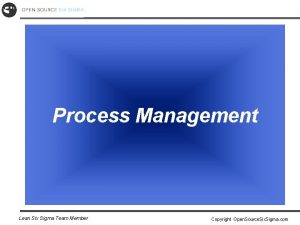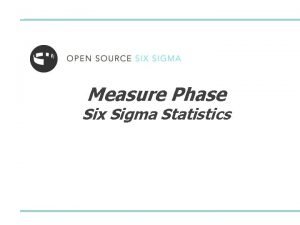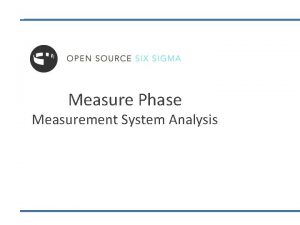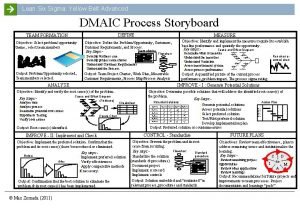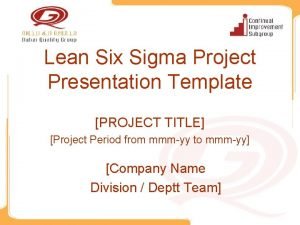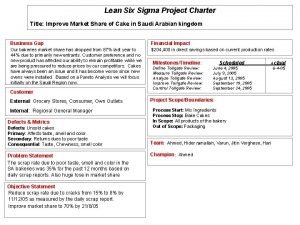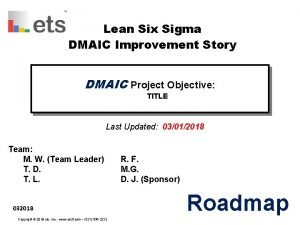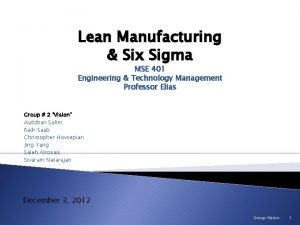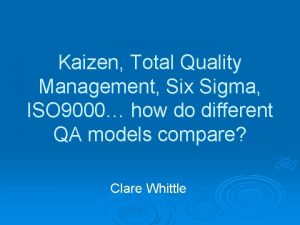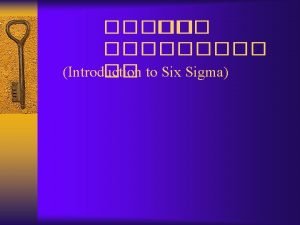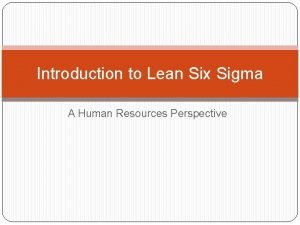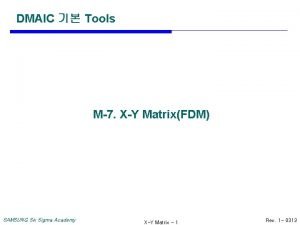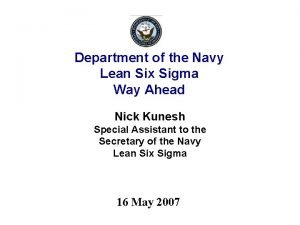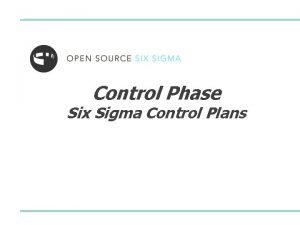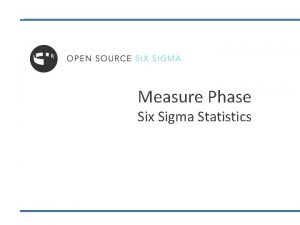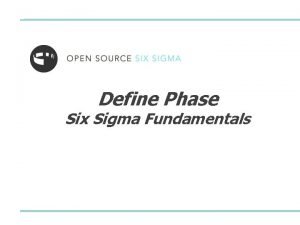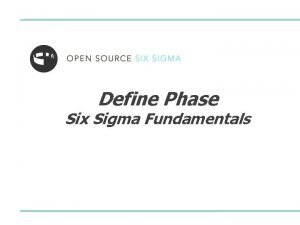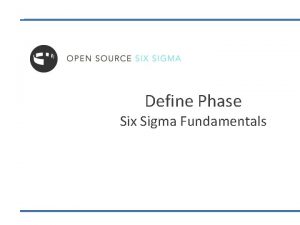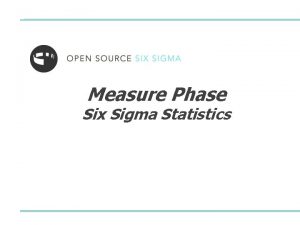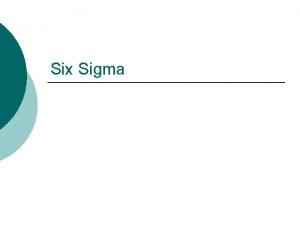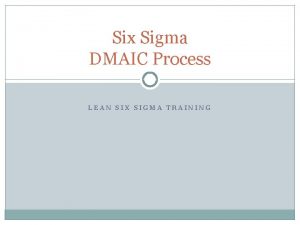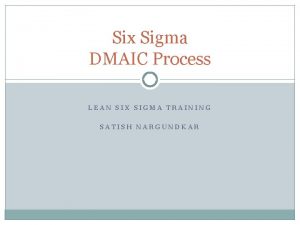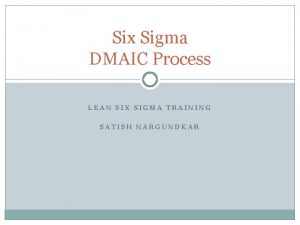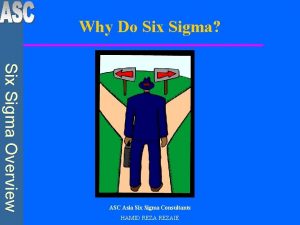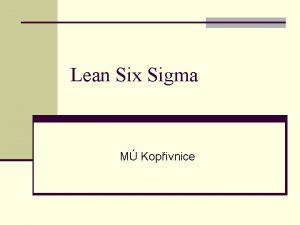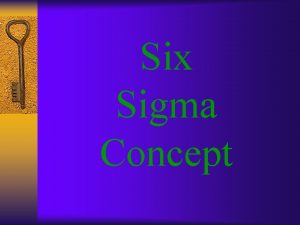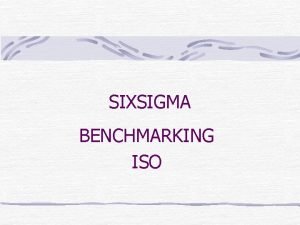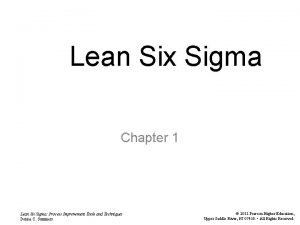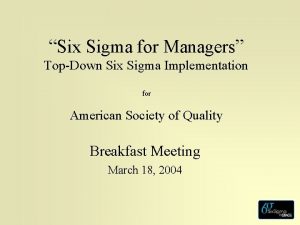Control Phase Six Sigma Control Plans Statistical Process









































- Slides: 41

Control Phase Six Sigma Control Plans

Statistical Process Control Welcome to Control Lean Controls Defect Controls Solution Selection Six Sigma Control Plans Wrap Up & Action Items Control Plan Elements 2

End of Control: Your Objectives You’ve already decided on the some defect reduction methodology. Final decisions need to clarify which defect reduction tools to use. – Capital expenditures may be required. – Training hurdles to overcome. – Management buy-in not completed. This module will help select solutions with a familiar tool. The Control Phase allows the Belt and its team to tackle other processes in the future. – The elements of a Control Phase aid to document how to maintain the process. This module identifies the elements of strong Control Plans. Remember: The objective is to sustain the gains initially found in the D, M, A, I Phases. 3

Selecting Solutions Selecting improvements to implement: – High-level objective evaluation of all potential improvements • Impact of each improvement • Cost to implement each improvement • Time to implement each improvement What’s next? ? – Balance desire with quantifiable evaluation • Engineering always wants the gold standard • Sales always wants inventory • Production always wants more capacity The tool for selecting defect prevention methods is unnecessary for just a few changes to the process. – Many projects with smaller scopes have few, but vital control methods put into the process. 4

Impact Considerations Impact of the improvement: – Time frame of improvements • Long-term vs. Short-term effectiveness – If a supplier will lose a major customer because of defects, the short term benefit will prevail first. – Effectiveness of the improvement types • Removing the Root Cause of the defect • Monitoring/flagging for the condition that produces a defect • Inspecting to determine if the defect occurred • Training people not to produce defects Now that’s IMPACT! 5

Cost Considerations Cost to implement improvement: – Initial cost to implement improvement • Cost to train existing work force • Cost to purchase any new materials necessary for improvement • Cost of resources used to build improvement • Any capital investments required – On-going costs to sustain improvement • Future training, inspection, monitoring and material costs It’s all about the cash! 6

Time Considerations Time to implement improvement: – Technical time constraints • What is the minimum time it would take to implement? – Time to build/create improvement, time to implement improvement – Political time constraints • What other priorities are competing for the technical time to build the improvement? – Cultural time constraints • How long will it take to gain support from necessary stakeholders? The clock’s ticking…… 7

Improvement Selection Matrix Implementing this familiar tool to prioritize proposed improvements is based on the three selection criteria of time, cost and impact. – All the process outputs are rated in terms of their relative importance to the process • The outputs of interest will be the same as those in your X-Y Matrix. • The relative ranking of importance of the outputs are the same numbers from the updated X-Y Matrix. – Each potential improvement is rated against the three criteria of time, cost, and impact using a standardized rating scale – Highest overall rated improvements are best choices for implementation 8

Improvement Selection Matrix Solution Matrix. xls 9

Improvement Selection Matrix Project Outputs Primary and Secondary Metrics of your Project. – List each of the Y’s across the horizontal axis – Rate the importance of the process Y’s on a scale of 1 to 10 • 1 is not very important, 10 is critical • The Significance rankings must match your updated X-Y Matrix rankings All even at the start! 10

Improvement Selection Matrix 11

Improvement Selection Matrix 12

Improvement Selection Matrix 13

Example of Completed Solution Selection Matrix Improvement Selection Matrix Output Improvements with the higher overall rating should be given first priority. Keep in mind that long time frame capital investments, etc. should have parallel efforts to keep delays from further occurring. 14

Implementing Solutions in Your Organization Implementation plans should emphasize the need to: – Organize the tasks and resources – Establish realistic time frames and deadlines – Identify actions necessary to ensure success Components of an implementation plan include: – Work breakdown structure – Influence strategy for priorities and resourcing – Risk management plan – Audit results for completion and risks. All solutions must be part of Control Plan Document. We have a plan don’t we? 15

What is a Control Plan? A Control Plan is: • Written summary describing systems used for monitoring/controlling process or product variation • Document allowing team to formally document all control methods used to meet project goal • Living document to be updated as new measurement systems and control methods are added for continuous improvement • Often used to create concise operator inspection sheet • NOT a replacement of information contained in detailed operating, maintenance, or design instructions • ESSENTIAL portion of final project report – Final projects are organizationally dependent • Informal or formal – Filed as part of project tracking mechanism for organization • Track benefits • Reference for unsustained results 16

WHO Should Create a Control Plan The team working on the project!!!! ANYONE who has a role in defining, executing or changing the process: – Associates – Technical Experts – Supervisors – Managers – Site Manager – Human Resources We did it!! 17

Why Do We Need a Control Plan? Project results need to be sustained. • Control Plan requires operators/engineers, managers, etc. to follow designated control methods to guarantee product quality throughout system • Allows a Belt to move onto other projects! • Prevents need for constant heroes in an organization who repeatedly solve the same problems • Control Plans are becoming more of a customer requirement Going for distance, not the sprint! 18

Control Plan Elements Control Plan Documentation Plan Response Plan Aligning Systems Monitoring Plan Training Plan Process owners accountable to maintain new level of process performance & Structures Implemented Improvements Verified Financial Impact 19

Control Plan Information The team develops the Control Plan by utilizing all available information from the following: – – – Results from the Measure and Analyze Phases Lessons learned from similar products and processes Team’s knowledge of the process Design FMEAs Design reviews Defect Prevention Methods selected Documentation Plan Response Plan Aligning Systems Monitoring Plan Training Plan & Structures 20

Training Plan Who/What organizations require training? – Those impacted by the improvements • People who are involved in the process impacted by the improvement • People who support the process impacted by the improvement Training Plan – Those impacted by the Control Plan • Process owners/managers • People who support the processes involved in the Control Plan • People who will make changes to the process in the future 21

Training Plan Who will complete the training? – Immediate training • The planning, development and execution is a Training Plan responsibility of the project team • Typically some of the training is conducted by the project team – Qualified trainers • Typically owned by a training department or process owner • Those who are responsible for conducting the on-going training must be identified Specific training materials need developing. – Power. Point, On the Job Checklist, Exercises, etc. 22

Training Plan When will training be conducted? What is the timeline to train everyone on the new process(es)? Training Plan What will trigger ongoing training? – New employee orientation? – Refresher training? – Part of the response plan when monitoring shows performance degrading? 23

Training Plan Outline Training Plan 24

Documentation Plan Documentation is necessary to ensure that what has been learned from the project is shared and institutionalized: – Used to aid implementation of solutions – Used for on-going training Documentation Plan This is often the actual Final Report some organizations use. Documentation must be kept current to be useful. 25

Documentation Plan Items to be included in the Documentation Plan: – Process documentation • Updated Process Maps/flowcharts • Procedures (SOP’s) • FMEA Documentation Plan – Control Plan documentation • Training manuals • Monitoring plan—process management charts, reports, sops • Response plan—FMEA • Systems and structures—job descriptions, performance management objectives 26

Documentation Plan Assigning responsibility for Documentation Plan: – Responsibility at implementation • Black Belt ensures all documents are current at hand off Documentation Plan • Black Belt ensures there is a process to modify documentation as the process changes in place • Black Belt ensures there is a process in place to review documentation on regular basis for currency/accuracy – Responsibility for ongoing process (organizationally based) • Plan must outline who is responsible for making updates/modifications to documentation as they occur • Plan must outline who is responsible to review documents— ensuring currency/accuracy of documentation 27

Documentation Plan Outline Documentation Plan 28

Monitoring Plan Purpose of a Monitoring Plan: – Assures gains are achieved and sustained – Provides insight for future process improvement activities Monitoring Plan Development of a Monitoring Plan: – Belt is responsible for the development of the monitoring plan – Team members will help to develop the plan – Stakeholders must be consulted – Organizations with financial tracking would monitor results. Sustaining the Monitoring Plan: – Functional managers will be responsible for adherence to the monitoring plan • They must be trained on how to do this • They must be made accountable for adherence 29

Monitoring Plan Knowledge Tests: – When to Sample • After training • Regular intervals • Random intervals (often in auditing sense) – How to Sample – How to Measure Monitoring Plan I knew I should have paid more attention! 30

Monitoring Plan Statistical Process Control: – Control Charts • Posted in area where data collected Monitoring Plan • Plot data points real time – Act on Out of Control Response with guidelines from the Out of Control Action Plan (OCAP). – Record actions taken to achieve in-control results. • Notes impacting performance on chart should be encouraged – Establishing new limits • Based on signals that process performance has changed 31

Response Plan FMEA is a great tool to use for the Monitoring Plan – Allows process manager and those involved in the process to see the entire process and how everyone contributes to a defect free product/service. – Provides the means to keep the document current—reassessing RPNs as the process changes 32

Monitoring Plan Check Lists/Matrices – Key items to check – Decision criteria; decision road map – Multi-variable tables Monitoring Plan Visual Management – Alerts or signals to trigger action. • Empty bins being returned to when need stock replenished • Red/yellow/green reports to signal process performance – Can be audible also. – 5 S is necessary for Visual Management 33

Response Plans — outline process(es) to follow when there is a defect or Out of Control from monitoring: – Out of control point on Control Chart – Non random behavior within Control Limits in Control Chart – Condition/variable proven to produce defects present in process – Check sheet failure – Automation failure Response to poor process results are a must in training. Response Plans are living documents updated with new information as it becomes available. 34

Response Plan Components of Response Plan: Response Plan – The triggers for a response • What are the Failure Modes to check for? • Usually monitor the highest risk X's in the process – The recommended response for the Failure Mode – The responsibilities for responding to the Failure Mode – Documentation of response plan being followed in a Failure Mode – Detailed information on the conditions surrounding the Failure Mode 35

Response Plan – Abnormality Report • Detailed documentation when failure modes occur. • Provide a method for on-going continuous improvement. • Reinforce commitment to eliminating defects. • Fits with ISO 9000 standard of having a CAR or Corrective Action Request. • Method to collect frequency of corrective actions. Response Plan 36

Aligning Systems and Structures Systems and structures are the basis for allowing people to change their behaviors permanently: – – – Performance goals/objectives Policies/procedures Job descriptions Incentive compensation Incentive programs, contests, etc Aligning Systems & Structures There are long- and short-term strategies for alignment of systems and structures. 37

Aligning Systems and Structures • Get rid of measurements that do not align with desired behaviors Aligning Systems • Get rid of multiple measures for the same desired behaviors & Structures • Implement measures that align with desired behaviors currently not motivated by incentives • Change management must consider your process changes and how the process will respond? • Are the hourly incentives hurting your chance of success? 38

Project Sign Off Best method to assure acceptance of Control Plan is having supervisors and management for the area involved. Aligning Systems & Structures – Meeting for a summary report – Specific changes to the process highlighted – Information where Control Plan is filed Now that’s a Control Plan! 39

End of Six Sigma Methodology At this point, you should be able to: • Identify all 5 phases of the Six Sigma methodology • Identify at least 3 tools from each phase • Show progress on your ongoing project 40

The Certified Lean Six Sigma Yellow Belt Assessment The Certified Lean Six Sigma Yellow Belt (CLSSYB) tests are useful for assessing a Yellow Belt’s knowledge of Lean Six Sigma. The CLSSYB can be used in preparation for the ASQ or IASSC Certified Six Sigma Yellow Belt exam or for any number of other certifications, including private company certifications. The Lean Six Sigma Yellow Belt Course Manual Open Source Six Sigma Course Manuals are professionally designed and formatted manuals used by Belt’s during training and for reference guides afterwards. The OSSS manuals complement the OSSS Training Materials and consist of slide content, instructional notes data sets and templates. Get the latest products at… www. opensourcesixsigma. com 41 Advertisement
 Six sigma statistical tools
Six sigma statistical tools 3 sigma value
3 sigma value Six sigma kanban
Six sigma kanban Six sigma process map symbols
Six sigma process map symbols Download six sigma foundations
Download six sigma foundations Control plan six sigma
Control plan six sigma Statistical process control ppt
Statistical process control ppt Spc in total quality management
Spc in total quality management Statistical process control tutorial
Statistical process control tutorial Sandia
Sandia Statistical process control
Statistical process control เฉล
เฉล Controle spc
Controle spc Statistical process control
Statistical process control Sigma sigma phi vcom
Sigma sigma phi vcom Vcom auburn white coat ceremony
Vcom auburn white coat ceremony Orientation to intermediate phase mathematics
Orientation to intermediate phase mathematics Cmmi six sigma
Cmmi six sigma Pilot plan template six sigma
Pilot plan template six sigma Explain the importance of tollgates in the dmaic process
Explain the importance of tollgates in the dmaic process Statapult exercise instructions
Statapult exercise instructions Who is this
Who is this Six sigma qualtec
Six sigma qualtec Six sigma forum
Six sigma forum Six sigma kpiv
Six sigma kpiv Mse six sigma
Mse six sigma Six sigma project template
Six sigma project template Six sigma belts hierarchy
Six sigma belts hierarchy Sigma statistics symbol
Sigma statistics symbol Msa attribute study kappa xls
Msa attribute study kappa xls Dmaic storyboard
Dmaic storyboard Pilot plan template six sigma
Pilot plan template six sigma 6 sigma project charter
6 sigma project charter Dmaic storyboard
Dmaic storyboard Ceinture blanche lean
Ceinture blanche lean Mse six sigma
Mse six sigma Total quality management kaizen
Total quality management kaizen Six sigma kpov
Six sigma kpov Human resources six sigma
Human resources six sigma Six sigma sony
Six sigma sony Six sigma kpiv
Six sigma kpiv Lean six sigma navy
Lean six sigma navy
